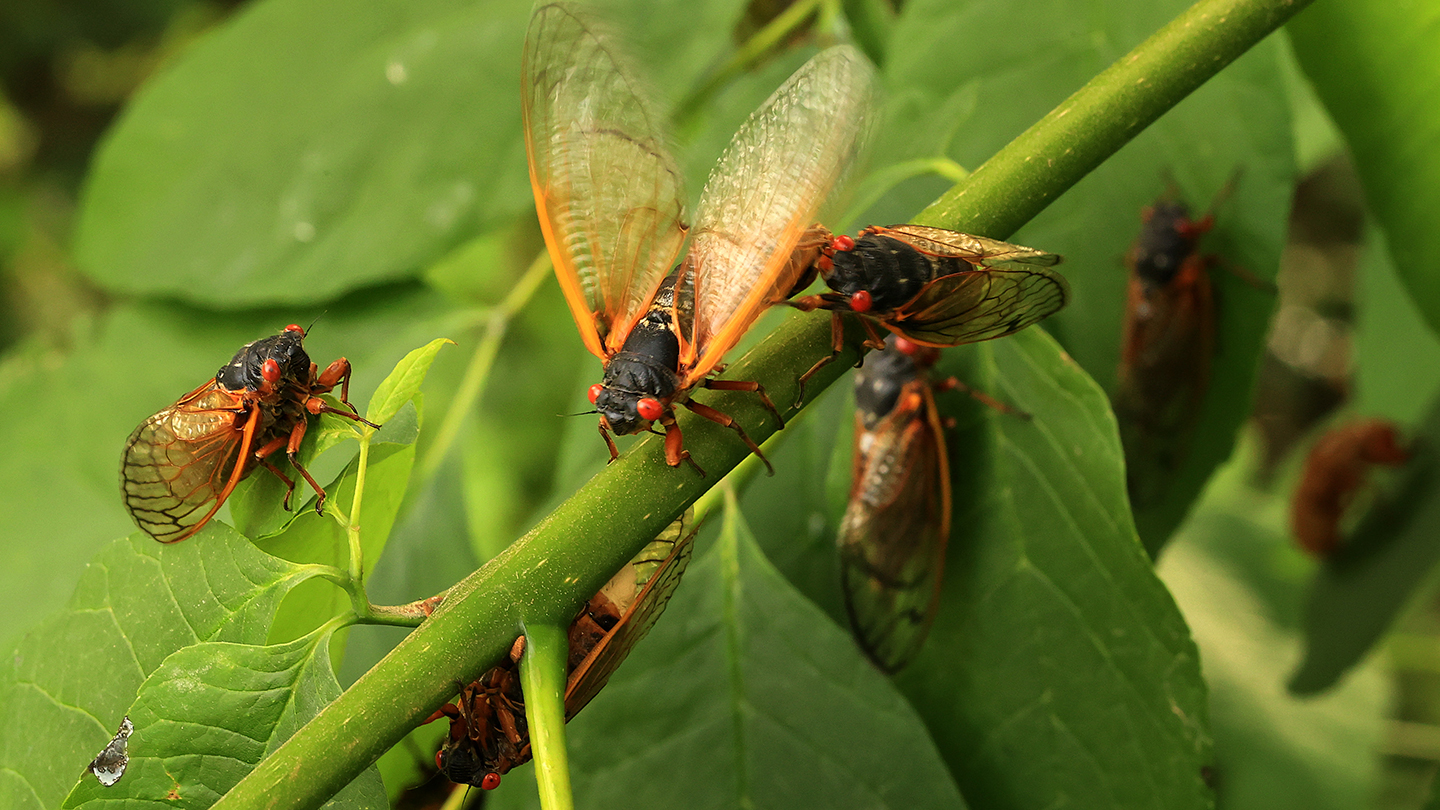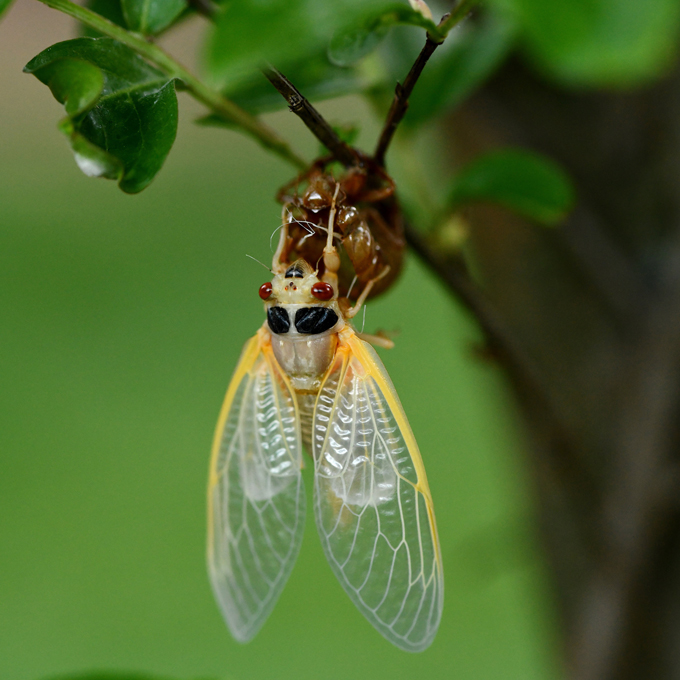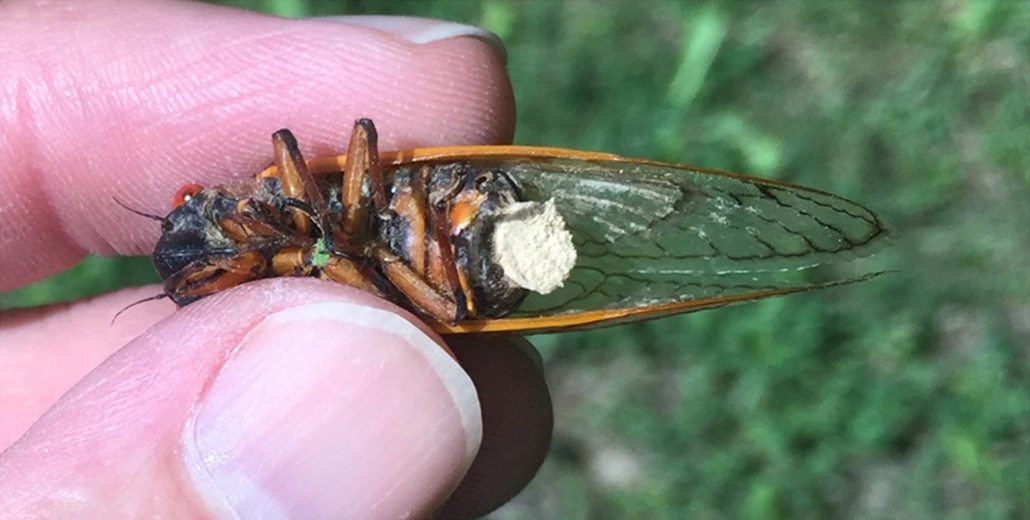Cicada science heats up when Brood X emerges. 2021 was no exception
In one of history’s weird coincidences, the second summer of a global pandemic

In one of history’s weird coincidences, the second summer of a global pandemic brought Johns Hopkins biologist Ethan Allen Andrews out on a Baltimore lawn to watch the massive Brood X cicada mating frenzy. The year was 1919 and a great influenza was still spreading around the world.
In 2021, the second summer of a different pandemic with many heartbreaking parallels, Brood X cicadas again sent people in the eastern United States onto their lawns in wonder, or into hiding from the mini projectiles and their high-decibel din.
Every 17 years, big-eyed Brood X Magicicada bugs as fat as fingers and defenseless as gummy bears fumble out of the ground by the millions. They orient toward various trees as if mystically called, then seethe over lawns in masses to converge and climb. “Astonishing,” Andrews called the view near a large tree. And that was before the mobs took their adult flying form and, after 17 asexual years, the males finally chorused for females.
“Ear drums nearly shattered by boiler-foundry din,” the Baltimore Sun exclaimed on May 30, 1919. Yet Andrews sounded thrilled. For three years, he had dug test holes to check on the young cicadas maturing underground. When they finally crawled into daylight, he sampled and calculated. “The entire number emerging from an acre of such suburban land runs up toward one hundred thousand,” he estimated.
When life gives you cicadas
This year, as Simon went south for intensive Brood X mapping in North Carolina and Georgia, she bought Brewed X coffee in Washington, D.C. She’s been immersed in the fascinating world of cicadas for decades, and collects instances of cicadas touching human culture. She can quote from a 1987 newspaper story reporting two men “brandishing” a cicada in a suspected robbery at the Grand Slam restaurant in Cincinnati, and she has a 2011 photo of the window of the beloved Sparky’s ice cream parlor in Columbia, Mo. The shop had sold out of cicada ice cream, so the staff taped up a note: “Check back in 2024.”
Looking back over her travels and worldwide research, this year Simon and long-time colleagues updated a synthesis of ideas about how Magicicada species evolved in three main lineages that diverged from a common ancestor some 3.9 million years ago. The periodical lifestyle evolved along with them, the researchers wrote online October 8 in the Annual Review of Entomology.
One factor on the path to periodicity is what Simon calls “predator foolhardiness.” Magicicada adults are big and weirdly easy to catch. They only halfheartedly try to escape predators. Even though birds, squirrels and plenty of other animals gorge on the easy meals, a sufficiently huge burst of cicadas can feed all the menaces and still leave enough survivors to reproduce. Reaching such mind-boggling abundance is easier when youngsters from a whole swath of countryside burst out of the ground together every 17 years.
This coordination can fit with a nutrient-skimpy diet and slow growth. Developing Magicicada youngsters tap tree roots for food, but ignore the higher-calorie fluid that carries sugars downward from the leaves. Instead, young cicadas drive their mouthparts into the up-sucking xylem, which carries roughly 99.9 percent water, with just a smidge of nutrients, from roots.
Feeding this way is hard work. To sip even such weak broth means a hard fight against the plant’s strong upward draw of fluids. To get the job done, cicadas, like other xylem specialists (SN: 8/14/21, p. 14), grow specialized power pumps in their heads.
What’s next
Brood X steals the headlines, but North America offers plenty more chances to see (and hear) 17- and 13-year periodical, bumbling bugs.
| Brood | Next emergence | |
| 17-year cicadas | Brood I | 2029 |
| Brood II | 2030 | |
| Brood III | 2031 | |
| Brood IV | 2032 | |
| Brood V | 2033 | |
| Brood VI | 2034 | |
| Brood VII | 2035 | |
| Brood VIII | 2036 | |
| Brood IX | 2037 | |
| Brood X | 2038 | |
| Brood XIII | 2024 | |
| Brood XIV | 2025 | |
| 13-year cicadas | Brood XIX | 2024 |
| Brood XXII | 2027 | |
| Brood XXIII | 2028 |
Spreading wings
Cicadas’ foolhardiness coupled with their extraordinary numbers brought a research bonanza for Mary Salcedo, a biomechanist at Virginia Tech in Blacksburg. She studies how newly adult insects quickly pump up their massive wings from the early squished-together tissue pads. Speed matters, as flightless means defenseless.
Cicadas can pump up their wings in only about 45 minutes. After studying the wings of lab locusts and grasshoppers, she enthusiastically turned to Magicicada: “Thousands of insects I don’t have to rear or care for!”
Before the first of Brood X pushed out of the ground this year, Salcedo booked an Airbnb rental outside Washington, D.C., for 10 (fully vaccinated) people from the Virginia Tech lab of biomechanist Jake Socha. The pandemic shut Socha’s lab in 2020, so the trip helped Ph.D. student Joshua Pulliam, for one, in his dramatic swerve to study cicada motion. He’s finding a way to fit insect climbing into his Ph.D. project on snakes that glide so well they just about fly (SN: 8/1/20, p. 16).

Salcedo has long wondered how insects manage to get huge wings flight-ready so fast. “Most people — I found, even some entomologists — think of an insect wing as like your hair,” she says. “But it’s … more like your arm.”
Instead of just inert stuff, insect wings have networks with nerves, airways and insect “blood,” or hemolymph. That complex system takes a lot of circulatory power, including extra hearts, says Salcedo, who is working with colleagues on a cicada wings paper. Cicadas have one central heart, plus more for the wings.
Unlike locusts and grasshoppers, which have a two-step wing reveal, the periodical cicada pulls its wings open all at once, like “pulling a sword out of a sheath,” Salcedo says. She Zoom-shares images of Brood X cicadas she caught and photographed during the recent excursion as they stretched out their wings for the first time. The starting shapes look like small, white sails with yellow squiggles. As those squiggles expand, the wings flare wider and longer, gradually coming to life.

Mind control
Forest pathologist Matt Kasson and his students also went cicada hunting in 2021, but not just any Brood X bumbler would do. Based at West Virginia University in Morgantown, the group searched in the Shenandoah Valley and nearby mountains for cicadas infected with a fungus that renders cicadas sterile but juices up their sex drive, maximizing fungal spread by mating contact.
“You have a cicada walking around with, basically, a chalky gumdrop [of fungus] on the backside of its abdomen,” Kasson says. These Massospora fungi drive males to mimic the flirtatious clicks of females, attracting other males. The duped males eventually catch on and clatter away, but they carry infectious fungi away with them.
Students Angie Macias and Matt Berger came up with the idea to study these fungi more than five years ago. There was no way to grow Massospora in labs, but the fungi attack both periodical and nonperiodical cicada species. One of the group’s first projects used nonperiodical cicadas from the American West to explore what chemistry could let a fungus energize insect sexual behavior.
“I get a call one snowy night in February at 2 in the morning,” Kasson remembers. It was from grad student Greg Boyce. He had a day job at a biotech company that let him use — after hours but for free — very expensive instruments to identify substances produced as an organism metabolizes. So in the dark of night, Boyce asked his adviser, “You know what psilocybin is?’’

Boyce had found that the legendary ingredient in a kind of magic mushroom, of all things, turned up naturally in a Massospora that attacks wing-banger cicadas (Platypedia putnami) from New Mexico.
By daylight “we were just like, holy crap!” Kasson says. This was especially surprising because the trippy mushrooms are far, far away from Massospora fungi in evolutionary history. The cicada attackers are in a whole different phylum, “way lower” on the fungal tree of life. Kasson thinks the same compound must have evolved twice, maybe a couple hundred million years apart.
“We got a bunch of colleagues looped in on that, and everybody was going nuts.” The big question was, did the periodical cicadas’ version of Massospora also have psilocybin?
The answer is, no. What turns out to drive periodical cicadas to hypersexed flirtation is a different stimulant: an amphetamine called cathinone. That same ingredient puts the kick in the khat plant, popularly chewed in the Middle East and not at all related to a fungus.
Eventually it dawned on Kasson that his cicada collecting had inadvertently filled his university lab with controlled substances for which he had no permits. “I wrote the most awkward letter of my life to the DEA,” he says.
In the end, the lab got squared away with the Drug Enforcement Administration. Insect mating–enhancement drugs have now become yet another tidbit of science that cicada watchers can muse over the next time their lawns start crawling.




